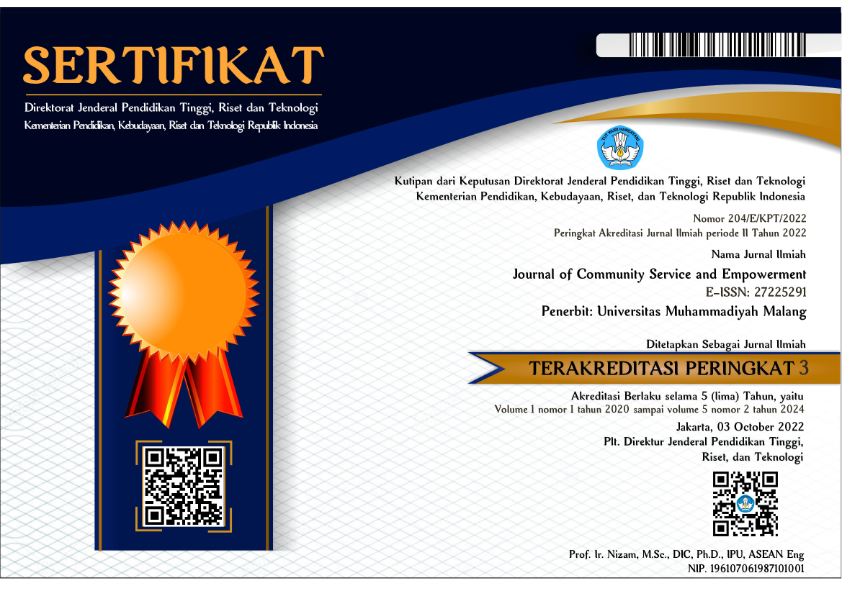Handwashing promotion and the use of hand sanitizer as a preventative measure on the development of bacteria
DOI:
https://doi.org/10.22219/jcse.v1i1.11510Keywords:
bacteria, hand sanitizer, hand washing promotion, preventative measureAbstract
A proper handwashing practice in Indonesia is around 49, 8%. A report from Basic Health Research 2018 recorded that Indonesians did not practice proper handwashing. This article aims to determine level of knowledge, number, and type of bacteria on hands. This community service program was conducted to 20 participants of the Regional Office of ‘Aisyiyah Malang through handwashing promotion using cleaners (such as soap, wet tissue, and hand sanitizer) to be applied to media called Nutrients Agar Plate (NAP). Then, the participants were to do gram staining to count number, type, and morphology of bacteria. The method implemented was desciptive data analysis. Finding shows that in the aspect of knowledge level, 75% of the participants were able to answer all questions correctly after the handwashing promotion program. On the count, there were 154 colonies of bacteria growing on unwashed fingers; 8 colonies on the fingers using hand sanitizer; 36 colonies on the fingers washed with soap, and 29 colonies with wet tissue. Handwashing habits provides knowledge to individuals of healthy living behaviour to prevent bacterial growth. It is concluded that hands washed with soap and running water, hand sanitizer, and wet tissue can actually reduce number of bacterial colonies as they contain bactericidal or bacteriostatic chemicals. Types of bacteria from coccus and Gram-positive rods are Staphylococcus, Streptococcus or Corynebacterium.Downloads
References
Benny E, W. (2010). Mikrobiologi kulit. Dalam A. Djuanda, Ilmu Penyakit Kulit dan Kelamin. Jakarta: FKUI.
Brilian, A. (2016). Gambaran Tingkat Pengetahunan dan Sikap Mencuci Tangan pada Ibu Rumah Tangga Anggota Posyandu di Wilayah Kerja UPTD Puskesmas Kecamatan Pontianak Utara. Jurnal Mahasiswa PSPD FK Universitas Tanjungpura, 3(1), 1-21. Retrieved from http://jurnal.untan.ac.id/index.php/jfk/article/view/16422
Burton, M. C. (2011). The effect of hand washing with water or soap on bacterial contamination of hands. . Int. J. Environ. Res. Public Health, 8(1), 97 - 104. https://doi.org/10.3390/ijerph8010097
El-shouny, W. A. E., El-Zaher, E. H. F. A., Khalil, M. A. E., El-Salam, O. A. E. (2014). Antimicrobial activity of Chamomile acetone extract against some Experimentally-indu
Finnegan, S. P. (2015). EDTA: An Antimicrobial and Antibiofilm ce Skin Infections in Mice. Egyption Journal of Environment Research, 2(2014), 58-70. Retrieved from https://www.researchgate.net/publication/280001493 Agent for Use in Wound Care. Advances in Wound Care, 4(7), 415-421. Retrieved from https://www.ncbi.nlm.nih.gov/pubmed/26155384
Haugen, H. L. (2016). Antibacterial Effects of Titanium dioxide in Wounds. Wound Healing Biomaterial, 2(26), 1-12.
Jawet, M. A. & Adelberg, A. (2017). Mikrobiologi kedokteran. Jakarta: EGC.
Kemenkes. (2014). Perilaku Mencuci Tangan Pakai Sabun di Indonesia. Jakarta: Infodatin, Pusat Data dan Informasi Kementrian Kesehatan RI.
Lalihta, C. R. & Rao, P. P. (2015). Antimicrobial Efficacy of Preservatives used in Skin Care Products on Skin Micro Biota. Journal of Science and Research, 4(6), 366-369. Retrieved from https://pdfs.semanticscholar.org/0541/5c97f35a37e8ad4eb06f579489528d05a4e1.pdf?_ga=2.14495287.1068177259.1588230925-1354831708.1580956150
Langsrud, S., Steinhauer, K., Lüthje, S., Weber, K., Goroncy-Bermes, P., Holck, A. L. (2016). Ethylhexyglyserin Impairs Membrane Integrity and Enhances the Lethal Effect of Phenoxyethanol. Retrieved from https://nofima.no/en/publication/1448473/
Benny E, W. (2010). Mikrobiologi kulit. Dalam A. Djuanda, Ilmu Penyakit Kulit dan Kelamin. Jakarta: FKUI.
Brilian, A. (2016). Gambaran Tingkat Pengetahunan dan Sikap Mencuci Tangan pada Ibu Rumah Tangga Anggota Posyandu di Wilayah Kerja UPTD Puskesmas Kecamatan Pontianak Utara. Jurnal Mahasiswa PSPD FK Universitas Tanjungpura, 3(1), 1-21. Retrieved from http://jurnal.untan.ac.id/index.php/jfk/article/view/16422
Burton, M. C. (2011). The effect of hand washing with water or soap on bacterial contamination of hands. . Int. J. Environ. Res. Public Health, 8(1), 97 - 104. https://doi.org/10.3390/ijerph8010097
El-shouny, W. A. E., El-Zaher, E. H. F. A., Khalil, M. A. E., El-Salam, O. A. E. (2014). Antimicrobial activity of Chamomile acetone extract against some Experimentally-induce Skin Infections in Mice. Egyption Journal of Environment Research, 2(2014), 58-70. Retrieved from https://www.researchgate.net/publication/280001493
Finnegan, S. P. (2015). EDTA: An Antimicrobial and Antibiofilm Agent for Use in Wound Care. Advances in Wound Care, 4(7), 415-421. Retrieved from https://www.ncbi.nlm.nih.gov/pubmed/26155384
Haugen, H. L. (2016). Antibacterial Effects of Titanium dioxide in Wounds. Wound Healing Biomaterial, 2(26), 1-12.
Jawet, M. A. & Adelberg, A. (2017). Mikrobiologi kedokteran. Jakarta: EGC.
Kemenkes. (2014). Perilaku Mencuci Tangan Pakai Sabun di Indonesia. Jakarta: Infodatin, Pusat Data dan Informasi Kementrian Kesehatan RI.
Lalihta, C. R. & Rao, P. P. (2015). Antimicrobial Efficacy of Preservatives used in Skin Care Products on Skin Micro Biota. Journal of Science and Research, 4(6), 366-369. Retrieved from https://pdfs.semanticscholar.org/0541/5c97f35a37e8ad4eb06f579489528d05a4e1.pdf?_ga=2.14495287.1068177259.1588230925-1354831708.1580956150
Langsrud, S., Steinhauer, K., Lüthje, S., Weber, K., Goroncy-Bermes, P., Holck, A. L. (2016). Ethylhexyglyserin Impairs Membrane Integrity and Enhances the Lethal Effect of Phenoxyethanol. Retrieved from https://nofima.no/en/publication/1448473/
Lipinwati, M. S. (2017). Efektivitas Mencuci Tangan dengan Sabun Cuci Tangan Cair Berbahan Aktif Triclocarban pada Mahasiswa Fakultas Kedokteran Universitas Jambi Angkatan 2015. Jambi Medical Journal, 5(1), 49 - 58. https://doi.org/10.22437/jmj.v5i1.3699
Mustikawati, I. S. (2017). Perilaku Cuci Tangan Pakai Sabun Studi Kualitatif pada Ibu-Ibu di Kampung Nelayan Muara Angke Jakarta Utara. ARKERMAS, 2(1), 115 - 125. https://doi.org/10.22236/arkesmas.v2i1.514
Nalawade, T. B. (2015). Bactericidal Activity of Propylene glycol, Glycerine, Polyethylene glycol 400, and Polyethylene 1000 against Selected Microorganisms. Journal of international society of preventive & community dentistry, 5(2), 114-119. https://doi.org/10.4103/2231-0762.155736
Permenkes. (2017). Peraturan Menteri Kesehatan Republik Indonesia Nomor 15 Tahun 2017 tentang Penanggulangan Cacingan. Jakarta: Menteri Kesehatan Republik Indonesia. Diambil kembali dari http://hukor.kemkes.go.id/uploads/produk_hukum/PMK_No._15_ttg_Penanggulangan_Cacingan_.pdf
Perrys, P. &. (2015). Fundamentals of Nursing – Australian Version 5th Edition. Mosby Australia.
Radji, M. S. (2007). Uji Efektivitas Antimikroba Beberapa Merek Dagang Pembersih Tangan Antiseptik. Majalah Ilmu Kefarmasian 4(1), 1-6. http://dx.doi.org/10.7454/psr.v4i1.3408
Riskesdas. (2018). Laporan Nasional Riskesdas. Kementerian Kesehatan RI. Badan Penelitian dan Pengembangan Kesehatan, 321-324 .
Rolf, U. H. (2014). On the Need and Speed of Regulating Triclosan and Triclocarban in the United States. Environmental Science & Technology, 48(7), 3603 - 3611. https://doi.org/10.1021/es500495p
Wahyuni, V. K. (2017). Perbandingan Efektivitas antara Gel Hands Sanitizer dan Tisu Basah Antiseptik Terhadap Jumlah Koloni Kuman di Tangan. Jurnal Cerebellum, 3(2), 808 - 819. Retrieved from http://jurnal.untan.ac.id/index.php/jfk/article/view/23260
Yanti, M., Alkafi, & Bustami. (2019). Perbedaan Tingkat Pengetahuan dan Sikap Terhadap Penyuluhan Cuci Tangan Pakai Sabun pada Siswa SD. Jurnal Ilmu Kesehatan (JIK), 3(2), 80-84. http://dx.doi.org/10.33757/jik.v3i2.219














